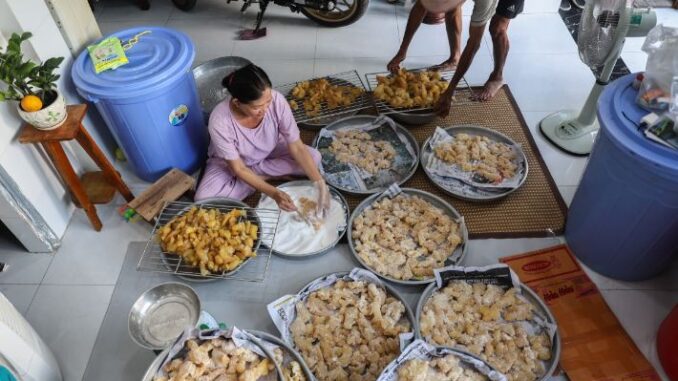
BINH DUONG – For the past two months, Ms. Tran Tuyet Phuong, 50 years old, in Hung Dinh ward, Thuan An city has been busy making ginger jam to sell during the Lunar New Year as has been a tradition for the past 70 years.

The ginger jam making village of Binh Duong province is concentrated around Binh Nham ward, Hung Dinh, Thuan An city, and is about 100 years old.
“My grandmother has been making jam all her life, now more than 70 years. Now in the neighborhood there are only a few families following the profession,” said Mrs. Phuong while drying ginger, noon on January 22.

Binh Duong’s typical ginger jam is left whole and sprinkled with white sugar instead of thinly sliced like other places. This Tet, she made 300 kg, losing 100 kg compared to last year.
“Probably due to economic difficulties, people are less likely to shop for Tet. Compared to some other households, my family still does a lot,” said Ms. Phuong.

Tet jam season starts from the 9th lunar month. The raw material for making jam is ginger imported from Dak Lak. Households in the village only use fragrant ginger because of its spicy and fragrant taste. The tubers are about the size of a hand, fresh, not too old so that they are less fibrous when eaten.

The peeled ginger is washed and then placed on a tray to be punctured. On average, each person shaves about 5 kg of ginger a day.
Before Click to flip the image back/before
Click to flip the image back/before
After
Mr. Ly Hoang Van (Ms. Phuong’s husband) carved ginger trays with a homemade machine, producing 20 kg per day. Taming is using a needle to pierce the ginger root to soften the ingredients and absorb the flavor more evenly. “This year, there is a machine so we can no longer do it manually, productivity has increased four times compared to before,” Mr. Van said.

After being infiltrated, the ginger root will be soaked in water, dried in the sun for four days and then boiled to remove all the spicy properties. After boiling, rinse in cold water, mix with sugar and continue drying for a few more days. During the soaking time, squeeze more lemon to make the ginger more flexible and clear.

In the ginger tubs that have been mixed with sugar, Mrs. Phuong uses a mosquito net to shield them from flies, bees, and ants while drying.

After more than a week of drying, the ginger is stored in large 50 kg buckets and waits until Tet to take out the slugs (cooked in sugar water). According to the factory owner, ginger through the stages of preliminary processing, marinating, boiling, and drying can be preserved for one year under normal conditions.

At noon on the same day, Mr. Van cooked ginger slug sugar water for about 10-15 minutes then took it out on a tray to drain. He said that jam slugging usually starts 20 days before the Lunar New Year and ends before December 15 to keep up with delivery.

The finished jam is soaked in white sugar water and must be continuously stirred so that the ginger does not burn and has a bright yellow color.
Before Click to flip the image back/before
Click to flip the image back/before
After
Inside the house, Mrs. Phuong rolls ginger in white sugar, the final step before canning. On average, one kilogram of fresh ginger will lose about 200 grams when the finished product is produced.

The pieces of ginger jam must have a beautiful yellow-brown color, the root must not be too crushed, soft, mildly spicy and have a characteristic aroma. Each box of jam has a wholesale price of 60,000 VND per half-kilo box and can be preserved for 4-5 months.
“To make a delicious piece of jam, we have to go through many difficult steps. None of our children follow this profession,” Ms. Phuong shared.
( According to vnexpress )
($1~24,000 VND)
